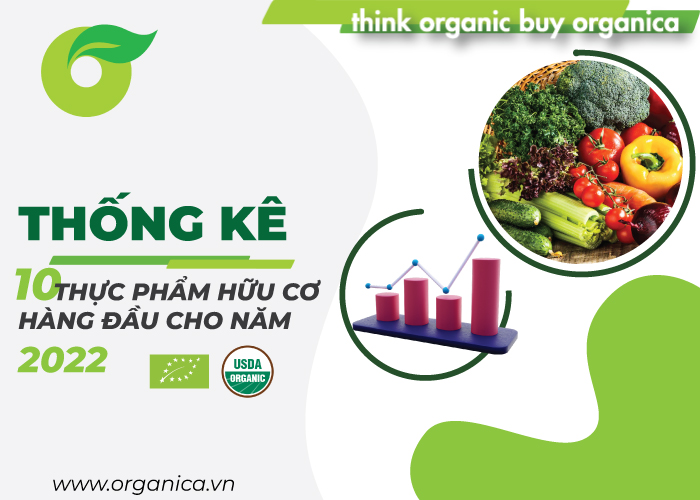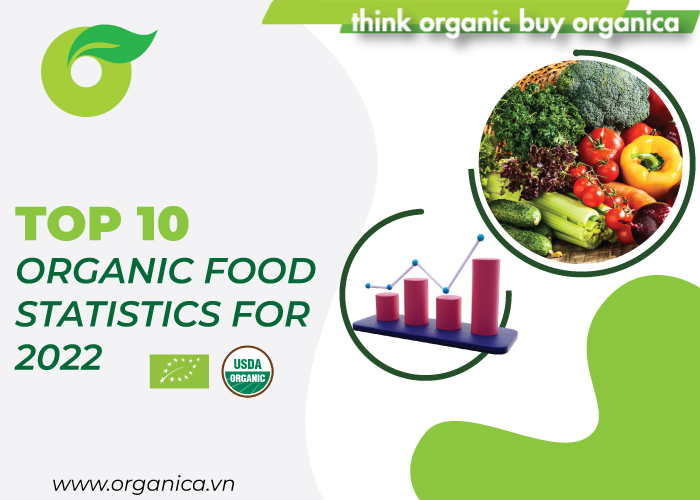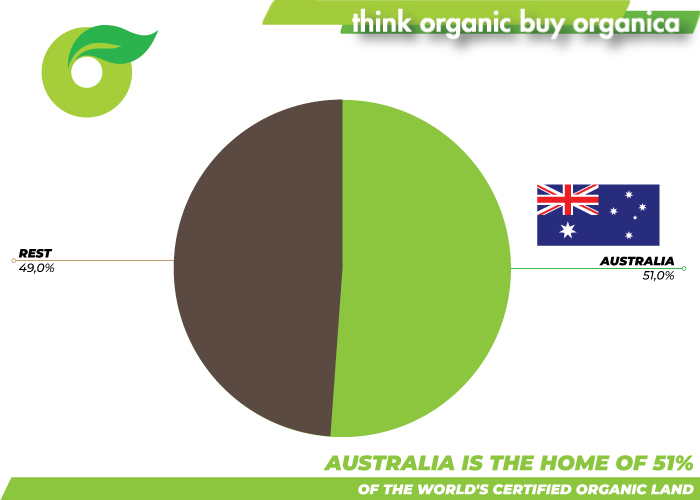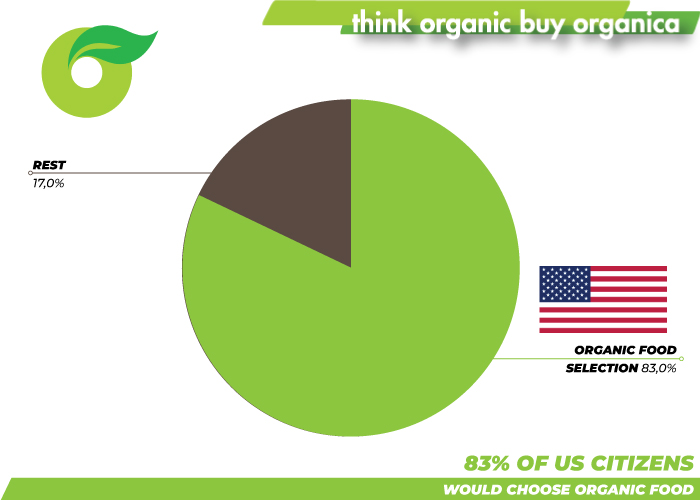


The global organic food and beverages market is projected to grow at a 16.44% CAGR during 2020–2025.
Denmark, Sweden, Switzerland, and Austria are the top spenders of organic foods and beverages.

Australia is the home of 51% of the world's certified organic land.
The Indian organic food market is expected to grow at a 20.5% CAGR in 2021–2026.
Organic vegetables and fruits comprise 14.6% of the total produce sold in the United States.
5.7% of food sold in America is organic, according to facts about organic food.

83% of US citizens will opt for organic, while the number of organic food proponents was 30% six years earlier.
62% of US consumers would purchase organic if it were more affordable.
Millennials with children are the most likely to spend money on organic food.
There are 20–40% more antioxidants in organic fruits and vegetables than in everyday foods.
The global organic food market is expected to grow from $201.77 billion in 2020 to $221.37 billion in 2021 at a compound annual growth rate (CAGR) of 9.7%. The growth is mainly due to the companies resuming their operations and adapting to the new normal while recovering from the COVID-19 impact, which had earlier led to restrictive containment measures involving social distancing, remote working, and the closure of commercial activities that resulted in operational challenges. The market is expected to reach $380.84 billion in 2025 at a CAGR of 14.5%.
The global organic food and beverages market size was valued at $187,485.6 million in 2020 and is estimated to reach $860,625.7 million by 2031, registering a CAGR of 14.9% from 2022 to 2031. The rising awareness among the consumers regarding the health benefits of organic products is driving the market growth.
Organic Food And Beverages Market Size Estimated to Reach a Value of USD 620.00 Billion by 2026.
According to the [190+ Pages] research report; the global Organic Food And Beverages Market in 2019 was approximately USD 220.00 Billion. The market is expected to grow at a CAGR of 16% and is anticipated to reach around USD 620.00 Billion by 2026. Top market players are Amy's Kitchen Inc., The Hain Celestial Group Inc., Private Label Companies, Organic Valley, General Mills, Inc., Whole Foods Market Inc. and others.
The COVID-19 pandemic has significantly boosted the growth of the global organic food and beverages market. According to the Organic Trade Association, the U.S. witnessed an all-time high sales of organic food and non-food items in 2020. The organic sales in the U.S. was recorded at $61.9 billion in 2020. The organic food witnessed a growth of 13% and the sales reached $56.5 billion in 2020. The increase in health-consciousness trend and the rise in focus of consumers towards healthy food intake during the pandemic to improve their immunity and gut health augment the demand for the organic food and beverages in the market.
The growing environmental concerns over the use of harmful chemicals in agriculture and farming and its ill-effects on consumers’ health result in the increase in demand for the organic food and beverages. The surge in prevalence of chronic diseases such as cancer, diabetes, and cardiovascular diseases among the global population, the increase in burden of infectious diseases, increase in healthcare expenditure, and the rise in health-consciousness trend are some of the prominent factors that shift consumers’ focus towards the adoption of healthy and quality food and beverages across the globe.
U.S. organic product sales climbed 12.4% in 2020, breaking the $60 billion mark for the first time and more than doubling the previous year’s growth, according to the Organic Trade Association (OTA).
The last time the U.S. organic product market saw double-digit sales growth was in 2015, when sales escalated 11.3% year over year, capping off four straight years of double-digit increases, OTA data show.
The pandemic caused abrupt changes in all of our lives. We’ve been eating at home with our families, and often cooking three meals a day,” she explained. “Good, healthy food has never been more important, and consumers have increasingly sought out the [USDA] Organic label.”
The global organic food and beverages market is segmented by product type and distribution channel. On the basis of product type, the market is segmented into organic foods and organic beverages. Organic food is further segmented into organic fruit & vegetables, organic meat, fish & poultry, organic dairy products, organic frozen & processed foods, and others. Similarly, organic beverages are further segmented into fruit and vegetable juices, dairy, coffee, tea, and others. On the basis of the distribution channel, the market is segmented into online retailers and offline retailers. The offline retailer is further segmented into hypermarket/supermarket, convenience stores, specialty stores, and others. On the basis of geography, the study provides an analysis of the organic food and beverage market in the emerging and established markets across the globe, including North America, Europe, Asia-Pacific, South America, and Middle East & Africa
Increase in Demand for Clean Label Products
Consumers demand clean labels on products to gain knowledge about the product that they are about to consume and at what level. Their interest in identifying the ingredients present in the food & beverage products has triggered the growth of the clean-label product market. The consumers avoid consuming products that contain synthetic ingredients, despite the price difference, as various published studies indicate that natural ingredients help avoid hyperactivity disorders and behavioral issues in children, among other benefits. Asia-Pacific has the fastest growth rate for clean-label products. According to research conducted by Ingredion, the ingredient company, Asia-Pacific showed the strongest demand for clean-label products, as compared to any other region.
Asia-Pacific Witnessed a Significant Market Growth
Asia Pacific is anticipated to project a rapid increase in CAGR during the forecast period, owing to the changing lifestyles and increase in consumer disposable income. Increasing awareness about the health benefits of organic food and beverages coupled with the advancement in biological farming techniques are anticipated to drive the demand for organic food and beverages in the region over the forecast period. The Asian market has a significant amount of imports of processed organic food and beverages from the developed countries of Europe and North America. The industrialized and developed countries such as Australia, New Zealand, Japan, Singapore, Hong Kong, and Korea are major markets for organic foods and beverages in the Asia Pacific. There is also an increase in demand for products in developing countries like India and China owing to the growing awareness about the benefits of organic food and beverage.
Global Organic Foods & Beverages Market to Reach US$495.9 Billion by the Year 2027
The U.S. Accounts for Over 29.6% of Global Market Size in 2020, While China is Forecast to Grow at a 13.4% CAGR for the Period of 2020-2027
The Organic Foods & Beverages market in the U.S. is estimated at US$58.6 Billion in the year 2020. The country currently accounts for a 29.56% share in the global market. China, the world second largest economy, is forecast to reach an estimated market size of US$86.1 Billion in the year 2027 trailing a CAGR of 13.4% through 2027. Among the other noteworthy geographic markets are Japan and Canada, each forecast to grow at 12.5% and 11.9% respectively over the 2020-2027 period. Within Europe, Germany is forecast to grow at approximately 10.2% CAGR while Rest of European market (as defined in the study) will reach US$86.1 Billion by the year 2027.